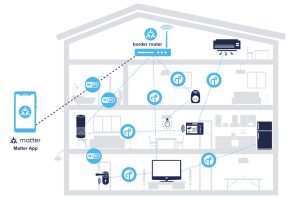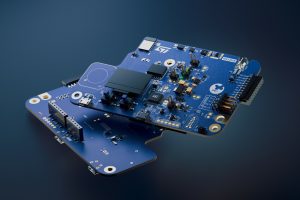Update, July 22, 2024
ST is thrilled to announce that X-CUBE-MATTER now supports Matter 1.3. A few months ago, we released a public version of the software package to ensure more developers could access it. With today’s release, we are now one of the first device makers to support the latest version of the standard. Among its many new features, Matter 1.3 brings energy reporting capabilities. As the name implies, devices can more easily declare how much electricity they consume, thus helping users monitor their energy consumption in real time. Another major feature is intermittency connected devices or ICDs.
In a nutshell, ICD enables Matter devices to turn themselves on at specific intervals to talk to the network, and the host doesn’t create issues when the client device is unreachable. While Matter 1.2 did support ICD with short idle time, Matter 1.3 support long idle time, making the technology significantly more interesting for small battery-powered devices. In fact, to show how developers can implement ICD, we are releasing a new “Generic-Switch-App” that can run a switch, like those used by smart lights. The switch can detect three states: pressed down, pressed down, and released shortly, and pressed down and released after five seconds.
Additionally, we worked with the CSA to better guarantee the interoperability of our solutions, ensuring developers don’t have to worry about this issue if they reuse our code. Traditionally, it’s the software engineers of the commercial products that undergo this process, not the processor’s manufacturer. However, by working with the CSA, we ensure an easier and quicker development process on ST radios. Similarly, we are providing pre-certified samples and tools to build the .OTA files that are needed for over-the-air updates using Matter, which facilitates the implementation of the certification process required by such a feature.
Original publication, March 19, 2024
We are thrilled to announce the release of X-CUBE-MATTER, our software expansion package with drivers, middleware, and pre-certified examples to help developers create Matter applications on the STM32WB55 while cutting down on developments. The software package can help deal with the more intricate aspects of the protocol and complex security implementations. Furthermore, while certifying products can take two to three months, using a pre-certified cluster can significantly shrink that. In a nutshell, X-CUBE-MATTER is ST’s love letter to the new protocol and a way to help its adoption.
The vision behind Matter
One protocol

Matter is the newest protocol to unite all home automation and other smart devices. It has the backing of major players such as Apple, Amazon, Google, and Samsung, among others. This is important because Matter focuses on interoperability and robustness. Hence, a wide adoption by the industry gives it a far greater chance of success. Ultimately, Matter wants to create a world where consumers can buy smart thermostats, automatic curtains, or connected lamps and not worry whether everything will work together. It relies on existing network standards, like Ethernet, Thread, Wi-Fi, or Bluetooth, for instance, and ensures all devices can talk to the controllers and each other.
Many challenges
The problem is that some perceive that Matter isn’t being deployed as rapidly as it should. And while one can argue that wireless protocols like Matter naturally take time, there are also some clear challenges. Some makers still perceive certification costs as high, and because Matter is still new, development cycles can be long and expensive. Hence, ST, a promoter member of the CSA, is now releasing X-CUBE-MATTER to address these two issues specifically. We are also working with members of the ST Partner Program to help developers manage their DAC provisioning and cloud infrastructure. Moreover, we are shipping the source code for the application example to jumpstart development. Let’s, therefore, dive into X-CUBE-MATTER more specifically.
The realization with X-CUBE-MATTER
The applications
The ST software package provides two major components: the protocol implementation and an applicative framework that’s been tested as a cluster. Currently, X-CUBE-MATTER includes smart lighting and a window covering control scheme. However, ST is also committing to two to three new releases per year, each adding new applications and, over time, support for new microcontrollers. In fact, the STM32 Hotspot on GitHub already features a Matter bridge example, which uses the NUCLEO-H753ZI and its Ethernet port to act as a gateway between Matter and non-Matter devices.
The networks
Similarly, while X-CUBE-MATTER focuses on Matter over Thread. The reason to focus on Thread is primarily because it’s the most energy-efficient and robust wireless standard for home automation. On the other hand, Bluetooth LE is traditionally employed for device commissioning. Hence, by focusing on Thread and BLE, we aim to help makers release their products to market faster by focusing on today’s trendiest wireless technology in this market.
The development tools

Another way X-CUBE-MATTER helps democratize Matter is by opening its development to more corporate environments. Today, most Matter development tools run on Linux and macOS. The problem is that many companies only or mainly use Windows because their IT department finds it easier to deploy and secure on the vast fleet that they manage. However, that can create a problem when developing for Matter. Since the STM32 ecosystem runs on all three operating systems, X-CUBE-MATTER leverages tools like STM32CubeMX or STM32CubeProgrammer that are popular on the Microsoft operating system, ensuring that more developers can rapidly create their application.
Furthermore, we offer optimization tools like STM32CubeMonitorRF, documentation, a community, and a detailed Wiki to help teams create their first system. For instance, the Matter Border Router repository on STM32 Hotspot provides screenshots and step-by-step instructions to setup environments, use the STM32WB5MM-DK development board to run Matter end-device example code, and use the STM32MP1 and P-NUCLEO-WB55 as a border router. ST chose the STM32WB5MM Development Kit because it has 16 MB of external Quad-SPI NOR flash. As the Matter stack has a large memory footprint, the board allows developers to implement all features mandated by the standard, such as over-the-air updates.
The certification
Another reason we chose the STM32WB55 is because of its dual-core, which allows developers to update the Cortex-M0+ or Cortex-M4 only, which can help with certifications. Instead of re-certifying the network stack after every minor applicative update, the ability to segregate application and network code on different cores can vastly simplify maintenance operations. As early adopters are clamoring for more Matter products from the industry, the STM32WB5MM-DK gives engineers reference design and implementation examples to release to market faster.
Moreover, the X-CUBE-MATTER software package has been pre-certified using the certification tools from the Connectivity Standard Alliance and used by Test Houses. It also includes Thread 1.3 and BLE 5.4 certifications. As a result, developers can benefit from a seamless certification path, thus reducing development costs and shortening their time to market.




